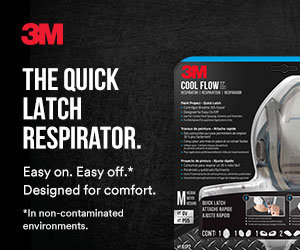 Jason Lunn is a 3M application engineering specialist for safety products. He oversees the training and education for a wide variety of safety products, including respirators. Here, he tackles a question that painting professionals often ask about reusable respirators.
Jason Lunn is a 3M application engineering specialist for safety products. He oversees the training and education for a wide variety of safety products, including respirators. Here, he tackles a question that painting professionals often ask about reusable respirators.
Q: How do I know when to change my cartridge and/or filter on a reusable respirator?
A: This is probably one of the most common questions we receive. While there are many factors unique to each situation, I can, however, offer you a general framework for how an answer can be found.
The first step is to make sure you have an OSHA-compliant respiratory protection program put together for your jobsite. This is where you need to record how and when to replace respirator cartridges and filters. Not only is this required by OSHA, it also takes the guesswork out of figuring out when to change a cartridge or filter.
Let’s start by defining filters and cartridges since they have vastly different methods of determining when to replace them. Filters are designed to help remove certain particles from the air such as dust, debris, and spray paint mist. To determine when you need to replace a filter, apply the ‘three Ds’ rule: If the filter is dirty, damaged, or difficult to breathe through, it’s time for a change.
Cartridges, on the other hand, are designed to help remove chemical vapors or gases (or a combination of those) from the air you breathe. This could be organic vapors from paints or perhaps acid gases from cleaning agents. To determine when to replace a cartridge, you need to find out how long it will last—also known as its ‘service life.’ This can vary based on factors such as the contaminants you are being exposed to, what the concentration levels are, the temperature and humidity, and even how heavy you are breathing.
To determine the cartridge ‘service life,’ you first need to know what you’re being exposed to, so start by consulting the Material Safety Data Sheet for potential airborne hazards. You’ll then need to conduct a hazard assessment to determine concentration levels. A hazard assessment should be done either by an industrial hygienist, your insurer, or through OSHA’s free On-Site Consultation Program, where an OSHA representative will visit your jobsite to assess it at no cost. I frequently recommend this service to contractors since it’s free, plus OSHA is not there to issue citations.
Once your hazard assessment is complete, enter that information into the 3M Select and Service Life calculator. The tool is free and can help calculate the number of hours of use your specific 3M cartridge will offer before requiring replacement (note that the software can only be used for 3M cartridges). You can use this service life to create a ‘change schedule,’ which is then recorded in a respiratory protection program.
Keep in mind that airborne hazards may contain particulates and chemicals. This would require a combination cartridge, which means a carbon cartridge with a particulate filter attached to it. Some cartridges have a filter attached to it that cannot be removed. If that filter needs to be replaced, you’ll need to throw out the entire combination cartridge, even if the cartridge portion has not met its service life. Other combination cartridges have detachable filters. On these, when the filter needs to be replaced, you can simply change the filter and continue to use the cartridge while it’s still within its service life.
And on one final note, situational or environmental changes may require changing a cartridge sooner than expected. If you are following all of the guidelines in your respiratory protection program but still smell, taste, or experience irritation from a gas or vapor on the job, leave the jobsite immediately, replace the cartridge or cartridge/filter combination, and re-check the seal of the respirator to your face.
To learn more visit 3M Reusable Respirators




